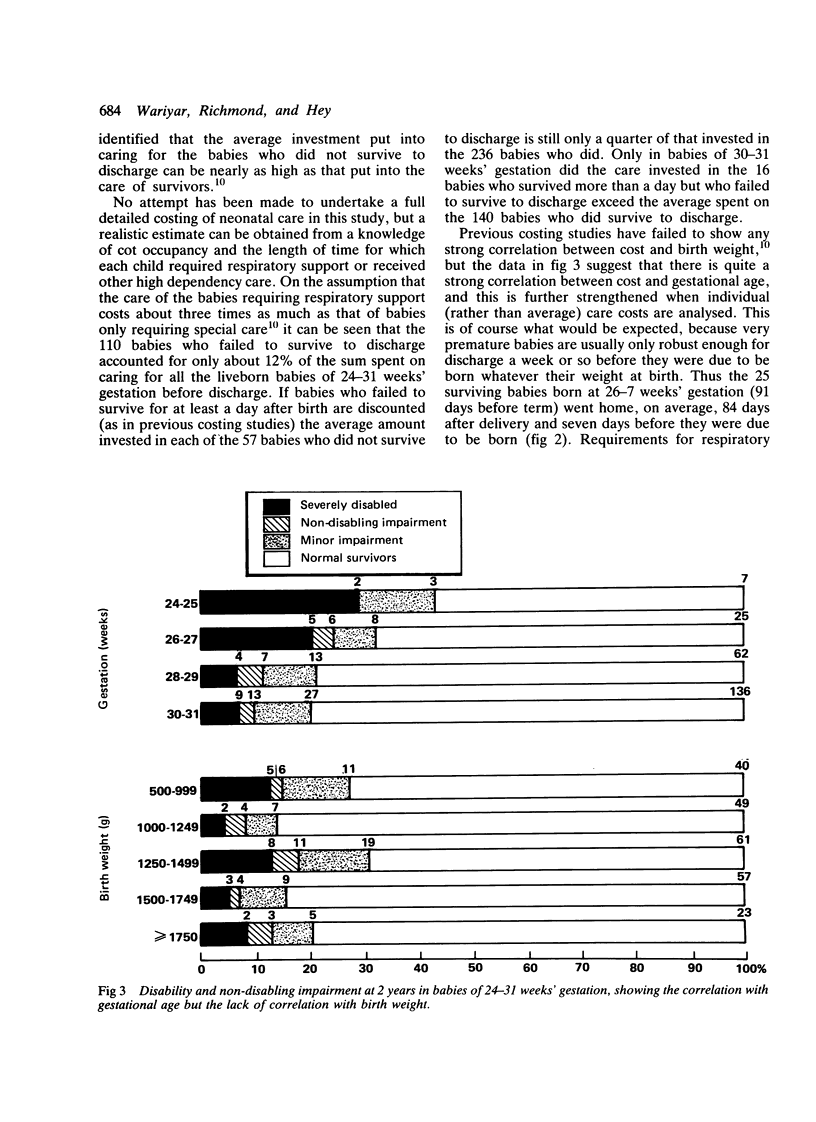Abstract
All surviving babies of less than 32 weeks' gestation born to mothers resident in the Northern region in 1983 were assessed. No baby was lost to follow up, and 230 long term survivors were assessed when 2 years old, by a single observer. Among 248 neonatal survivors, severe disability was present in 10 of the 37 at 24-27 weeks' gestation (27%) and in 18 of the 211 at 28-31 weeks' gestation (9%). On average the surviving babies required 27 days and seven days of intensive care nursing respectively. Babies who were ventilated for more than two weeks and babies who had neonatal fits had a poor prognosis. Because of postneonatal deaths only 20 of the 230 long term survivors of less than 32 weeks' gestation were severely disabled (9%). Comparable data were obtained for all babies weighing 1500 g or less at birth, irrespective of their gestational age. Severe disability was seen in eight of the 49 neonatal survivors (16%) who had weighed 500-999 g at birth, and in 17 of the 171 survivors (10%) who had weighed 1000-1499 g. The 10 neonatal survivors who had weighed exactly 1500 g at birth were all well. Only 18 of the 212 long term survivors (8%) who had weighed 1500 g or less at birth were severely disabled. Because the period of gestation is the only variable known to the obstetrician before delivery, and disability correlates better with gestation than birth weight, future studies should concentrate on relating morbidity, mortality, and the cost of neonatal care to gestation rather than weight at birth.
Full text
PDF








Selected References
These references are in PubMed. This may not be the complete list of references from this article.
- Francis-Williams J., Davies P. A. Very low birthweight and later intelligence. Dev Med Child Neurol. 1974 Dec;16(6):709–728. doi: 10.1111/j.1469-8749.1974.tb03392.x. [DOI] [PubMed] [Google Scholar]
- Parkinson C. E., Wallis S., Harvey D. School achievement and behaviour of children who were small-for-dates at birth. Dev Med Child Neurol. 1981 Feb;23(1):41–50. doi: 10.1111/j.1469-8749.1981.tb08445.x. [DOI] [PubMed] [Google Scholar]
- Powell T. G., Pharoah P. O., Cooke R. W. Survival and morbidity in a geographically defined population of low birthweight infants. Lancet. 1986 Mar 8;1(8480):539–543. doi: 10.1016/s0140-6736(86)90893-7. [DOI] [PubMed] [Google Scholar]
- Sandhu B., Stevenson R. C., Cooke R. W., Pharoah P. O. Cost of neonatal intensive care for very-low-birthweight infants. Lancet. 1986 Mar 15;1(8481):600–603. doi: 10.1016/s0140-6736(86)92820-5. [DOI] [PubMed] [Google Scholar]
- Saunders M. C., Dick J. S., Brown I. M., McPherson K., Chalmers I. The effects of hospital admission for bed rest on the duration of twin pregnancy: a randomised trial. Lancet. 1985 Oct 12;2(8459):793–795. doi: 10.1016/s0140-6736(85)90792-5. [DOI] [PubMed] [Google Scholar]
- Verloove-Vanhorick S. P., Verwey R. A., Brand R., Gravenhorst J. B., Keirse M. J., Ruys J. H. Neonatal mortality risk in relation to gestational age and birthweight. Results of a national survey of preterm and very-low-birthweight infants in the Netherlands. Lancet. 1986 Jan 11;1(8472):55–57. doi: 10.1016/s0140-6736(86)90713-0. [DOI] [PubMed] [Google Scholar]
- Wariyar U. K., Richmond S. Morbidity and preterm delivery: importance of 100% follow-up. Lancet. 1989 Feb 18;1(8634):387–388. doi: 10.1016/s0140-6736(89)91764-9. [DOI] [PubMed] [Google Scholar]
- Wariyar U., Richmond S., Hey E. Pregnancy outcome at 24-31 weeks' gestation: mortality. Arch Dis Child. 1989 May;64(5):670–677. doi: 10.1136/adc.64.5.670. [DOI] [PMC free article] [PubMed] [Google Scholar]
- Watkins A., Szymonowicz W., Jin X., Yu V. V. Significance of seizures in very low-birthweight infants. Dev Med Child Neurol. 1988 Apr;30(2):162–169. doi: 10.1111/j.1469-8749.1988.tb04747.x. [DOI] [PubMed] [Google Scholar]
- Whittaker P. G., Lind T., Lawson J. Y. A prospective study to compare serum human placental lactogen and menstrual dates for determining gestational age. Am J Obstet Gynecol. 1987 Jan;156(1):178–182. doi: 10.1016/0002-9378(87)90233-x. [DOI] [PubMed] [Google Scholar]
- Yu V. Y., Loke H. L., Bajuk B., Szymonowicz W., Orgill A. A., Astbury J. Prognosis for infants born at 23 to 28 weeks' gestation. Br Med J (Clin Res Ed) 1986 Nov 8;293(6556):1200–1203. doi: 10.1136/bmj.293.6556.1200. [DOI] [PMC free article] [PubMed] [Google Scholar]
- Yu V. Y., Watkins A., Bajuk B. Neonatal and postneonatal mortality in very low birthweight infants. Arch Dis Child. 1984 Oct;59(10):987–989. doi: 10.1136/adc.59.10.987. [DOI] [PMC free article] [PubMed] [Google Scholar]
- Yudkin P. L., Aboualfa M., Eyre J. A., Redman C. W., Wilkinson A. R. Influence of elective preterm delivery on birthweight and head circumference standards. Arch Dis Child. 1987 Jan;62(1):24–29. doi: 10.1136/adc.62.1.24. [DOI] [PMC free article] [PubMed] [Google Scholar]
- Yudkin P. L., Aboualfa M., Eyre J. A., Redman C. W., Wilkinson A. R. New birthweight and head circumference centiles for gestational ages 24 to 42 weeks. Early Hum Dev. 1987 Jan;15(1):45–52. doi: 10.1016/0378-3782(87)90099-5. [DOI] [PubMed] [Google Scholar]


